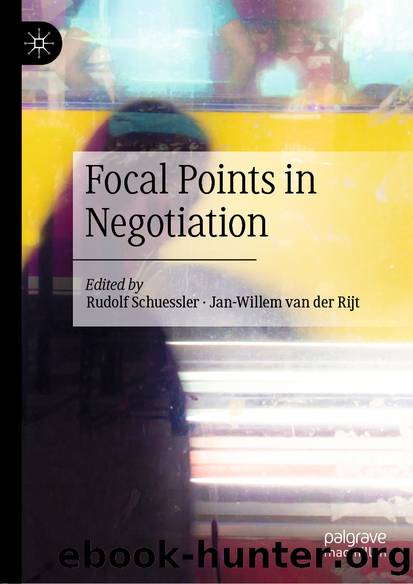Focal Points in Negotiation by Unknown

Author:Unknown
Language: eng
Format: epub
ISBN: 9783030279011
Publisher: Springer International Publishing
4 Classifying Arms Control Solutions
Arms control agreements and negotiating positions contain plenty of numbers, designations of various types of borders and other easily formalized parameters. How many of them meet the criteria of focal points? Do focal point solutions in arms control break down into distinct types? From the focal point perspective, three types of solutions embodied in arms control agreements are identified here. Solutions may have no connection with focal points whatsoever (1); represent a salient point that âcompetesâ with an alternative salient point (2); or rely on an âisolatedâ focal point with no clear salient alternative in sight (3).
Outcomes of the first type of arms control negotiations are not based on any focal point. The majority of negotiated arms control solutions represent this type of outcome. Such solutions are reached without reliance on any symmetry or appealing number. In many cases, numbers in arms control negotiations are chosen in a consensual manner without the need to attract negotiating parties to a position they would otherwise consider suboptimal based on their interests. In such situations, the appeal of the number may be present, but is not necessary to override or alter anyoneâs initial negotiating position. Only a small share of numbers in arms control agreements conform to the definition of a focal point.
For example, the round numbers used extensively in the New START (2010) and Conventional Forces in Europe (1990) treaties were not needed as tools to draw the positions of the sides closer to one another; agreement on these numbers came relatively easy for the negotiating parties before having to address more controversial issues. According to senior negotiators involved in the most recent round of strategic arms control talks between the US and Russia, the ceilings for deployed nuclear warheads to be enshrined in the New START Treaty of 2010 were in fact not difficult to agree upon. Neither side considered it a major concession to commit to a maximum of 1550 deployed warheads and 800 deployed and non-deployed carriers.11
In a similar vein, the Conventional Forces in Europe (CFE) Treaty signed in 1990 and the preceding negotiations on âmutual and balanced force reductionsâ in Europe involved dozens of numbers, most of which, according to the existing accounts of CFE negotiations, were in no way focal or salient.
In arms control negotiations, in general, numbers often generate less contention than, for example, the terms according to which the sides will be monitoring and verifying implementation of the negotiated agreement. In these and many other cases, the round numbersâ âfocal promiseâ, which can be defined as the power of attraction, was either unnecessary or weak.
Arms control solutions of the second type rely on what I call a non-equilibrium focal point. This is a focal point in whose vicinity is another salient point, meaning that a shift from one to the other can occur relatively easily and oftentimes unexpectedly. One example of non-equilibrium focal points are counter-value and counter-force targeting principles in nuclear strategy. Each principle has an underlying coherent logic that can be adopted by the mutually deterring sides.
Download
This site does not store any files on its server. We only index and link to content provided by other sites. Please contact the content providers to delete copyright contents if any and email us, we'll remove relevant links or contents immediately.
Time Management Made Easy: How to Cultivate New Habits, Improve Productivity and Get Things Done by Joshua Strachan(2365)
The 7 Habits of Highly Effective People by Stephen R. Covey & Sean Covey(2098)
The Concise Laws of Human Nature by Robert Greene(1715)
Doesn't Hurt to Ask by Trey Gowdy(1555)
Primal Leadership by Daniel Goleman(1125)
Hook Point: How to Stand Out in a 3-Second World by Brendan Kane(1098)
HBR's 10 Must Reads 2021 by unknow(1044)
Don't Sweat the Small Stuff...and It's All Small Stuff by Richard Carlson(1014)
Amazon Unbound by Brad Stone(979)
100 Things Successful People Do by Nigel Cumberland(963)
HBR's 10 Must Reads 2021 by Harvard Business Review(956)
The Job Closer by Steve Dalton(939)
Master of One by Jordan Raynor(934)
Lives of the Stoics by Ryan Holiday & Stephen Hanselman(900)
Declutter Your Mind: A step by step guide to learn to control your thoughts, stop worrying, relieve anxiety and eliminate panic attacks and negative thinking by Mia Chandler(875)
The Power of 100! by Shaun King(844)
Conflicted by Ian Leslie(798)
Coders at Work: Reflections on the craft of programming by Peter Seibel(787)
The Book of Hope by Jane Goodall(744)
